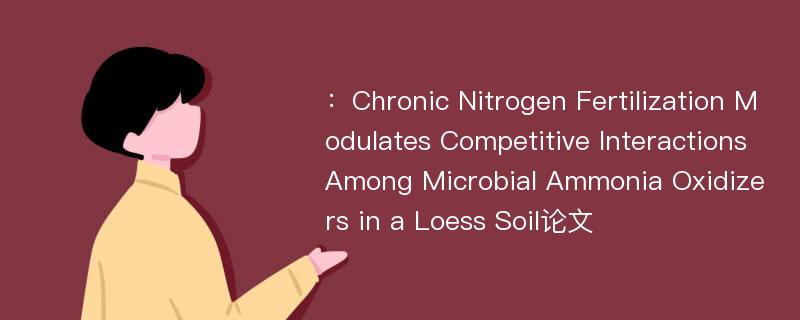
本文主要研究内容
作者(2019)在《Chronic Nitrogen Fertilization Modulates Competitive Interactions Among Microbial Ammonia Oxidizers in a Loess Soil》一文中研究指出:Nitrogen(N) application may lead to niche segregation of soil ammonia-oxidizing archaea(AOA) and bacteria(AOB), thereby reducing the competitive interactions between AOA and AOB due to higher ammonium substrate availability. However, the adaptive mechanisms of AOA and AOB under N enrichment remain poorly understood. Stable isotope probing(SIP) microcosm incubation was employed to reveal community changes of active AOA and AOB in a loess soil from a field experiment growing potatoes that received no N(control, CK), low N(LN, 75 kg N ha-1), and high N(HN, 375 kg N ha-1). The results showed that the soil potential nitrification rate(PNR) was measured by culturing of the soil samples from the field experiment. Soil PNR was significantly increased in HN by87.5% and 67.5% compared with CK and LN, respectively. Compared with CK, the13C-amoA genes of soil AOA and AOB in HN had 2.58 × 104 and 1.55 × 106 copies, representing 1.6-and 16.2-fold increase respectively. It was indicated that AOB dominated soil ammonia oxidation. A phylogenetic analysis of the13C-amoA gene showed that N application significantly increased the proportion of54 d9-like AOA up to 90% in HN, while the Nitrososphaera gargensis-like and Nitrososphaera viennensis-like AOA were inhibited and completely disappeared. Nitrogen application also resulted in the community shift of active AOB-dominant group from Nitrosospira briensis-like to Nitrosospira sp. TCH711-like. Our study provides compelling evidence for the emergence and maintenance of active nitrifying communities under the intensified N input to an agricultural ecosystem.
Abstract
Nitrogen(N) application may lead to niche segregation of soil ammonia-oxidizing archaea(AOA) and bacteria(AOB), thereby reducing the competitive interactions between AOA and AOB due to higher ammonium substrate availability. However, the adaptive mechanisms of AOA and AOB under N enrichment remain poorly understood. Stable isotope probing(SIP) microcosm incubation was employed to reveal community changes of active AOA and AOB in a loess soil from a field experiment growing potatoes that received no N(control, CK), low N(LN, 75 kg N ha-1), and high N(HN, 375 kg N ha-1). The results showed that the soil potential nitrification rate(PNR) was measured by culturing of the soil samples from the field experiment. Soil PNR was significantly increased in HN by87.5% and 67.5% compared with CK and LN, respectively. Compared with CK, the13C-amoA genes of soil AOA and AOB in HN had 2.58 × 104 and 1.55 × 106 copies, representing 1.6-and 16.2-fold increase respectively. It was indicated that AOB dominated soil ammonia oxidation. A phylogenetic analysis of the13C-amoA gene showed that N application significantly increased the proportion of54 d9-like AOA up to 90% in HN, while the Nitrososphaera gargensis-like and Nitrososphaera viennensis-like AOA were inhibited and completely disappeared. Nitrogen application also resulted in the community shift of active AOB-dominant group from Nitrosospira briensis-like to Nitrosospira sp. TCH711-like. Our study provides compelling evidence for the emergence and maintenance of active nitrifying communities under the intensified N input to an agricultural ecosystem.
论文参考文献
论文详细介绍
论文作者分别是来自Pedosphere的,发表于刊物Pedosphere2019年01期论文,是一篇关于,Pedosphere2019年01期论文的文章。本文可供学术参考使用,各位学者可以免费参考阅读下载,文章观点不代表本站观点,资料来自Pedosphere2019年01期论文网站,若本站收录的文献无意侵犯了您的著作版权,请联系我们删除。
